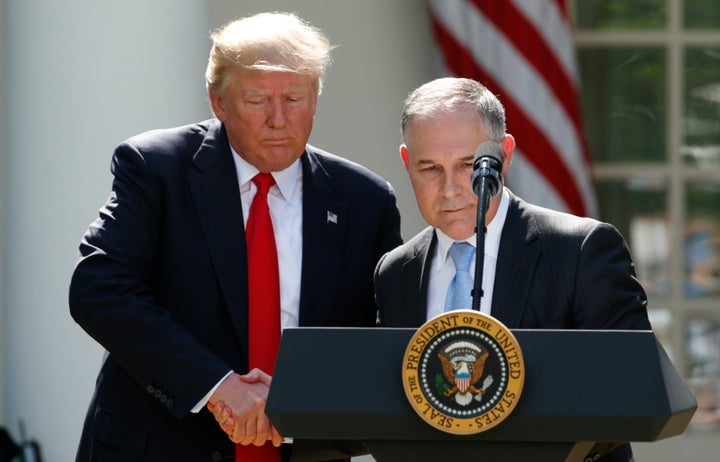The Environmental Protection Agency has proposed scrapping the only major rule limiting greenhouse gas emissions from power plants, leaving the United States without a clear national strategy to combat climate change.
On Tuesday, EPA Administrator Scott Pruitt issued a notice of proposed rulemaking for a formal repeal of the Clean Power Plan, the sweeping set of regulations the Obama administration put in place in 2015 to reduce planet-warming gases from the utility sector.
Coal-fired power plants produce about one-third of the country’s electricity and one-third of its greenhouse gases. The plan was the most comprehensive action the U.S. had taken to combat planet-warming emissions, and was meant to spur a faster conversion to sources of energy with fewer emissions.
“The Obama administration pushed the bounds of their authority so far with the CPP that the Supreme Court issued a historic stay of the rule, preventing its devastating effects to be imposed on the American people while the rule is being challenged in court,” Pruitt said in a news release Tuesday. “We are committed to righting the wrongs of the Obama administration by cleaning the regulatory slate.”
The repeal would fulfill President Donald Trump’s promise to undo former President Barack Obama’s environmental legacy. Trump signed an executive order in March instructing Pruitt to review power plant regulations he called “stupid” and “a crushing attack on American industry.”
In June, Trump announced the U.S. was withdrawing from the Paris agreement, the global pact to slash emissions that every country other than war-torn Syria has now adopted.
Eliminating the Clean Power Plan makes the country far less likely to meet the goals agreed to under the accord, although a number of states, cities and large corporations have said they will continue to reduce emissions and convert to renewable energy.
The policy, temporarily blocked by the Supreme Court in February 2016, never went into effect, and kiboshing it could save the U.S. $33 billion in “avoided costs” by 2030, according to the EPA’s calculations. (Environmental advocates accused the EPA of “cooking the books” on its numbers on Tuesday.) But that comes at the cost of public health, according to doctors, who warned on an American Lung Association conference call Tuesday that the Clean Power Plan’s demise would worsen air pollution and exacerbate illnesses such as asthma.
If implemented, the Clean Power Plan would have provided rewards for early investments in wind and solar power and supplied incentives for energy efficiency programs in low-income communities. Repealing it would make the country more reliant on fossil fuels and delay the sort of energy shift already aggressively underway in places such as Europe and China.
Pruitt said on Monday that he’d like to “do away with” tax credits and other incentives for renewable energy, forcing the nascent wind and solar industries to compete head-to-head with heavily subsidized fossil fuels without government assistance. “The war on coal is over,” he said at an event with coal miners in Kentucky.

The EPA is still required to take action on carbon emissions under a 2009 determination, known as the “endangerment finding,” that greenhouse gas emissions pose a threat to human health and well-being. That finding came in response to an earlier Supreme Court ruling that said the agency was obligated to regulate any type of air pollution that “may reasonably be anticipated to endanger public health or welfare” under the 1970 Clean Air Act.
The prospect of overturning the endangerment finding is low, as it would require the administration to disprove the overwhelming evidence that increased carbon emissions cause global warming. In the leaked draft of the repeal, the EPA wrote: ”The substance of the 2009 Endangerment Finding is not at issue in this proposed rulemaking, and we are not soliciting comment on the EPA’s assessment of the impacts of greenhouse gases with this proposal.”
The EPA did not propose a replacement to the Clean Power Plan in its repeal, stating that it was “considering whether it is appropriate to propose such a rule.”
“Any replacement rule will be done carefully, properly, and with humility, by listening to all those affected by the rule,” Pruitt said Tuesday.
To revoke the rule, Pruitt argues that the EPA doesn’t have the authority to force utility companies to invest in renewable energy. He made the same case as Oklahoma’s attorney general last year, when he led more than a dozen states in a lawsuit to halt the plan’s implementation in the Supreme Court.
Pruitt’s narrow legal interpretation, to be submitted to the Federal Register on Tuesday, suggests the agency can only mandate individual power plants to reduce emissions through minimal steps, such as increasing efficiency by upgrading coal boilers to avoid losing some heat. Those types of improvements could increase efficiency by about 4 percent, previous EPA analyses found.
Such minimal regulations would pass the muster for hard-line climate critics such as Myron Ebell, the Competitive Enterprise Institute scholar who led the EPA transition team.
“Obviously [the Competitive Enterprise Institute] would prefer repealing the so-called Clean Power Plan and not replacing it, but if a replacement is necessary, then a legal inside-the-fenceline rule would be acceptable,” Ebell wrote to HuffPost in an email, referring to energy efficiency rules for individual plants.
But the EPA’s argument that it still wants to reduce emissions within a specific legal framework isn’t being made in good faith, according to Joseph Goffman, a former senior EPA official under Obama. If the administration were earnestly looking for the best legal path to reduce carbon pollution, it would seek other ways to enforce that rule, such as mandating stricter use of technology to capture and store emissions.
“When you do rulemaking like this, if you’re seriously in the business of addressing CO2 emissions from power plants, and you’re convinced that the proposed legal interpretation defines the limits of what you can do, then you start looking very much more aggressively at technological options,” Goffman, who is joining the environmental law program at Harvard Law School at the end of this month, told HuffPost.
“We are committed to righting the wrongs of the Obama administration by cleaning the regulatory slate.”
- EPA Administrator Scott Pruitt
Plus, Pruitt has repeatedly stated that he doubts the how much carbon emissions cause climate change, bucking scientists’ broad consensus in favor of an argument from industries chafing under greenhouse gas restrictions.
There’s speculation among both Republicans and Democrats that Pruitt plans to run for office in Oklahoma, possibly for the Senate seat held by 82-year-old Republican Jim Inhofe, whose fifth term ends in 2020. Pruitt spent much of his early months at the EPA flying home to Oklahoma, and his visits to other states could be aimed at shoring up support from key donors, Politico reported in August.
In that case, the EPA may use bureaucratic processes to bog down any replacement to the finding, kicking it down the road to 2020.
The proposal for repeal will require months of public comment. After that, the EPA could seek public comment on any replacement, potentially drawing out the process for years ― not to mention the lawsuits expected from environmental groups and Democratic state attorneys general. New York Attorney General Eric Schneiderman announced plans to defend the Clean Power Plan in court against the Trump administration’s “persistent and indefensible denial of climate change.” Massachusetts Attorney General Maura Healey also said she would sue.
“There will no doubt be litigation, which could last several years, but Scott Pruitt and his team have worked hard to do an analysis that is legal, which is a laudable contrast to the multiple illegalities in the CPP,” Ebell said.
Since being stayed by the Supreme Court, the Clean Power Plan has been under litigation the U.S. Court of Appeals for the D.C. Circuit. The court must now decide whether to allow the EPA time to come up with a replacement that fulfills its obligations under the endangerment finding, or to allow the litigation over the future of the plan to continue.
So far, the court has ruled in favor of giving the the administration time to act on the Clean Power Plan, including a 60-day extension granted in August.
Stan Meiburg, a former acting deputy EPA administrator who spent 39 years at the agency, told HuffPost that the court has taken the administration at its word that it’s going to pass something to replace the Clean Power Plan, and has postponed any future action on litigation to give the administration time to make its argument. “That patience may not last forever,” Meiburg said.

